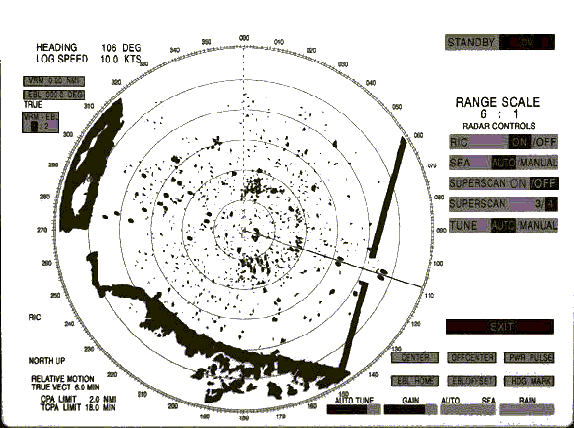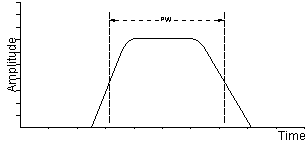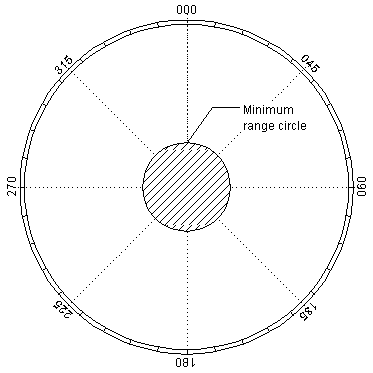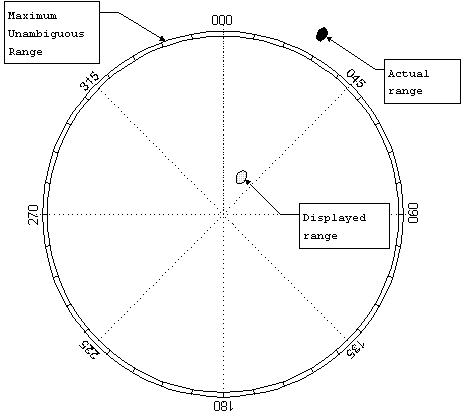
 Introduction to
Naval Weapons Engineering
Introduction to
Naval Weapons EngineeringBasic Radar Systems
Principle of Operation
Radar is an acronym
for Radio Detection and Ranging. The term "radio"
refers to the use of electromagnetic waves with wavelengths in
the so-called radio
wave portion of the spectrum, which covers a wide range from 104
km to 1 cm. Radar
systems typically use wavelengths on the order of 10 cm, corresponding
to frequencies
of about 3 GHz. The detection and ranging part of the acronym
is accomplished by
timing the delay between transmission of a pulse of radio energy
and its subsequent
return. If the time delay is Dt,
then the range may be determined by the simple
formula:
R = cDt/2
where c = 3 x 108 m/s, the speed of light at which
all electromagnetic waves propagate.
The factor of two in the formula comes from the observation that
the radar pulse must
travel to the target and back before detection, or twice the range.
A radar pulse train
is a type of amplitude modulation of the radar frequency
carrier wave, similar to how carrier waves are modulated in communication
systems.
In this case, the information signal is quite simple: a
single pulse repeated at
regular intervals. The common radar carrier modulation,
known as the pulse train
is shown below. The common parameters of radar as defined
by referring to Figure 1.
PW = pulse width. PW has units of time and is commonly expressed in ms. PW is the duration of the pulse. RT = rest time. RT is the interval between pulses. It is measured in ms. PRT = pulse repetition time. PRT has units of time and is commonly expressed in ms. PRT is the interval between the start of one pulse and the start of another. PRT is also equal to the sum, PRT = PW+RT. PRF = pulse repetition frequency. PRF has units of time-1 and is commonly expressed in Hz (1 Hz = 1/s) or as pulses per second (pps). PRF is the number of pulses transmitted per second and is equal to the inverse of PRT. RF = radio frequency. RF has units of time-1 or Hz and is commonly expressed in GHz or MHz. RF is the frequency of the carrier wave which is being modulated to form the pulse train.
Mechanization
A practical radar system requires seven basic components as illustrated
below:
Figure 3
Transmitter. The transmitter creates the radio wave to
be sent and modulates it to form the pulse train. The transmitter
must also amplify the signal to a high power level to provide
adequate range. The source of the carrier wave could be
a Klystron, Traveling Wave Tube (TWT) or Magnetron. Each
has its own characteristics and limitations.
2. Receiver. The receiver is sensitive to the
range of frequencies being transmitted and provides amplification
of the returned signal. In order to provide the greatest
range, the receiver must be very sensitive without introducing excessive
noise. The ability to discern a received signal from background
noise depends on the signal-to-noise ratio (S/N).
The background noise
is specified by an average value, called the noise-equivalent-power
(NEP). This directly equates the noise to a detected power level
so that it may be compared to the return. Using these definitions,
the criterion for successful detection of a target is
Pr > (S/N) NEP,
where Pr is the power of the return signal. Since this
is a significant quantity in determining radar system performance,
it is given a unique designation, Smin, and is called
the Minimum Signal for Detection.
Smin = (S/N) NEP
Since Smin, expressed in Watts, is usually a small
number, it has proven useful to define the decibel equivalent,
MDS, which stands for Minimum Discernible Signal.
MDS = 10 Log (Smin/1 mW)
When using decibels, the quantity inside the brackets of the logarithm
must be a number without units. I the definition of
MDS, this number is the fraction Smin /1 mW.
As a reminder, we use the special notation dBm for the units of
MDS, where the "m" stands for 1 mW.
This is shorthand for decibels referenced to 1 mW, which
is sometimes written as dB//1mW.
In the receiver, S/N
sets a threshold for detection which determines what will
be displayed and what will not. In theory, if S/N = 1, then
only returns with power equal to or greater than the background
noise will be displayed. However, the noise is a statistical
process and varies randomly. The NEP is just the average
value of the noise. There will be times when the noise exceeds
the threshold that is set by the receiver. Since this
will be displayed and appear to be a legitimate target, it
is called a false alarm. If the SNR is set too high, then
there will be few false alarms, but some actual targets may not
be displayed known as a miss). If SNR is set too low,
then there will be many false alarms, or a high false alarm
rate (FAR).
Some receivers monitor
the background and constantly adjust the SNR to maintain
a constant false alarm rate, and therefore all called CFAR receivers.
Some common receiver
features are:
1.) Pulse Integration. The receiver takes an
average return strength over many pulses. Random events
like noise will not occur in every pulse and therefore, when averaged,
will have a reduced effect as compared to actual targets that
will be in every pulse.
2.) Sensitivity Time Control (STC). This feature
reduces the impact of returns from sea state. It reduces
the minimum SNR of the receiver for a short duration immediately
after each pulse is transmitted. The effect of adjusting the STC
is to reduce the clutter on the display in the region directly
around the transmitter. The greater the value of STC,
the greater the range from the transmitter in which clutter
will be removed. However, an excessive STC will blank out
potential returns close to the transmitter.
3.) Fast Time Constant (FTC). This feature is designed
to reduce the effect of long duration returns that come from
rain. This processing requires that strength of the return
signal must change quickly over it duration. Since rain
occurs over and extended area, it will produce a long, steady
return. The FTC processing will
filter these returns out of the display. Only pulses that
rise and fall quickly will be displayed. In technical
terms, FTC is a differentiator, meaning it determines
the rate of change in the signal, which it then uses to discriminate pulses
which are not changing rapidly.
3. Power Supply. The power supply provides
the electrical power for all the components. The largest
consumer of power is the transmitter which may require several
kW of average power. The actually power transmitted in the
pulse may be much greater than 1 kW. The power supply
only needs to be able to provide the average amount of power
consumed, not the high power level during the actual
pulse transmission. Energy can be stored, in a capacitor
bank for instance, during the rest time. The stored
energy then can be put into the pulse when transmitted, increasing
the peak power. The peak power and the average power are
related by the quantity called duty cycle, DC. Duty cycle
is the fraction of each transmission cycle that the radar
is actually transmitting. Referring to the pulse train
in Figure 2, the duty cycle can be seen to be:
DC = PW / PRF
Synchronizer. The synchronizer coordinates the timing for range determination.
It regulates that rate at which pulses are sent (i.e. sets PRF)
and resets the timing
clock for range determination for each pulse. Signals from
the synchronizer are sent
simultaneously to the transmitter, which sends a new pulse,
and to the display,
which resets the return sweep.
Duplexer. This is a switch which alternately connects the
transmitter or receiver to the antenna. Its purpose is to protect
the receiver from the high power output of the transmitter. During
the transmission of an outgoing pulse, the duplexer will be aligned
to the transmitter for the duration of the pulse, PW. After the
pulse has been sent, the duplexer will align the antenna to the
receiver. When the next pulse is sent, the duplexer will shift
back to the transmitter. A duplexer is not required if the transmitted
power is low.
Antenna. The antenna takes the radar pulse from the transmitter and puts it into the air. Furthermore, the antenna must focus the energy into a well-defined beam which increases the power and permits a determination of the direction of the target. The antenna must keep track of its own orientation which can be accomplished by a synchro-transmitter. There are also antenna systems which do not physically move but are steered electronically (in these cases, the orientation of the radar beam is already known a priori).
The beam-width
of an antenna is a measure of the angular extent of the
most powerful portion of the radiated energy. For
our purposes the main portion,
called the main lobe, will be all angles from the perpendicular
where the power
is not less than ½ of the peak power, or, in decibels, -3
dB. The beam-width is
the range of angles in the main lobe, so defined. Usually
this is resolved into
a plane of interest, such as the horizontal or vertical plane.
The antenna will
have a separate horizontal and vertical beam-width. For
a radar antenna, the
beam-width can be predicted from the dimension of the antenna
in the plane of
interest by
q = l/L
where:
q is the beam-width in radians,
l is the wavelength of the
radar, and
L is the dimension of the antenna, in
the direction of interest (i.e. width or height).
In the discussion of
communications antennas, it was stated that the
beam-width for an antenna could be found using q
= 2l/L. So it appears
that radar
antennas have one-half of the beam-width as communications
antennas. The difference
is that radar antennas are used both to transmit and receive the
signal. The
interference effects from each direction combine, which has the
effect of reducing
the beam-width. Therefore when describing two-way systems
(like radar) it is
appropriate to reduce the beam-width by a factor of ½ in
the beam-width
approximation formula.
The directional
gain of an antenna is a measure of how well the beam is
focused in all angles. If we were restricted to a single
plane, the directional
gain would merely be the ratio 2p/q.
Since the same power is distributed over a
smaller range of angles, directional gain represents the
amount by which the power
in the beam is increased. In both angles, then directional
gain would be given by:
Gdir = 4p/q f
since there are 4p steradians corresponding
to all directions (solid angle, measured
in steradians, is defined to be the area of the beam front
divided by the range
squared, therefore a non-directional beam would cover an area
of 4pR2
at distance R,
therefore 4p steradians).
Here we used:
q = horizontal beam-width
(radians)
f = vertical beam-width (radians)
Sometimes directional gain is measured in decibels, namely 10
log (Gdir).
As an example, an antenna with a horizontal beam-width
of 1.50 (0.025 radians) and
vertical beam-width of 20o (0.33 radians)
will have:
directional gain(dB) = 10 log (4 p/
0.025 0.333) = 30.9 dB
Example: find the horizontal and vertical beam-width of
the AN/SPS-49 long
range radar system, and the directional gain in dB. The antenna
is 7.3 m wide
by 4.3 m tall, and operates at 900 MHz.
The wavelength, l=c/f = 0.33 m.
Given that L= 7.3 m, then
q = l/L
= 0.33/7.3 = 0.045 radians, or
q = 30.
The antenna is 4.3 m tall, so a similar
calculation gives
f = 0.076 radians
f = 40.
The directional gain,
Gdir = 4p/(0.045
0.076) = 3638.
Expressed in decibels,
directional gain = 10 Log(3638)
= 35.6 dB.
Display. The display unit may take a variety of forms but in general is designed to present the received information to an operator. The most basic display type is called an A-scan (amplitude vs. Time delay). The vertical axis is the strength of the return and the horizontal axis is the time delay, or range. The A-scan provides no information about the direction of the target.
Figure 4
The most common display is the PPI (plan position indicator). The A-scan information is converted into brightness and then displayed in the same relative direction as the antenna orientation. The result is a top-down view of the situation where range is the distance from the origin. The PPI is perhaps the most natural display for the operator and therefore the most widely used. In both cases, the synchronizer resets the trace for each pulse so that the range
information will begin at the origin. 
Figure 5
In this example, the use of increased STC to suppress the sea clutter would be helpful.
Radar performance
All
of the parameters of the basic pulsed radar system will affect
the
performance in some way. Here we find specific examples
and quantify this dependence
where possible.
Pulse Width
The duration of the pulse and the length of the target along the
radial direction
determine the duration of the returned pulse. In
most cases the length of the
return is usually very similar to the transmitted pulse. In the
display unit, the
pulse (in time) will be converted into a pulse in distance.
The range of values
from the leading edge to the trailing edge will create some uncertainty
in the
range to the target. Taken at face value, the ability to
accurately measure range
is determined by the pulse width.
If we designate the
uncertainty in measured range as the range resolution,
RRES, then it must be equal to the range equivalent
of the pulse width, namely:
RRES = c PW/2
Now, you may wonder why not just take the leading edge of the
pulse as the
range which can be determined with much finer accuracy?
The problem is that it is
virtually impossible to create the perfect leading edge.
In practice, the ideal
pulse will really appear like:

Figure 6
To create a perfectly formed pulse with a vertical leading edge would require an infinite bandwidth. In fact you may equate the bandwidth, b, of the transmitter to the minimum pulse width, PW by:
PW = 1/2b
Given this insight, it is quite reasonable to say that the range can be determined no more accurately than cPW/2 or equivalently
RRES = c/4b
In fact, high resolution radar is often referred to as wide-band
radar which you now see as equivalent statements. One term is
referring to the time domain and the other the frequency domain.
The duration of the pulse also affects the minimum range at which
the radar system can detect. The outgoing pulse must physically
clear the antenna before the return can be processed. Since this
lasts for a time interval equal to the pulse width, PW, the minimum
displayed range is then:
RMIN = c PW/2
The minimum range effect can be seen on a PPI display as a saturated
or blank area
around the origin.

Figure 7
Increasing the pulse width while maintaining the other parameters the same will also affect the duty cycle and therefore the average power. For many systems, it is desirable to keep the average power fixed. Then the PRF must be simultaneously changed with PW in order to keep the product PW x PRF the same. For example, if the pulse width is reduced by a factor of ½ in order to improve the resolution, then the PRF is usually doubled.
Pulse Repetition Frequency (PRF)
The frequency of pulse
transmission affects the maximum range that can be
displayed. Recall that the synchronizer resets the timing
clock as each new pulse
is transmitted. Returns from distant targets that do no
reach the receiver until
after the next pulse has been sent will not be displayed correctly.
Since the timing
clock has been reset, they will be displayed as if the range where
less than actual.
If this were possible, then the range information would be considered
ambiguous.
An operator would not know whether the range were the actual range
or some greater
value.

Figure 8
The maximum actual range that can be detected and displayed without
ambiguity, or the maximum unambiguous range, is just the
range corresponding to a time interval equal to the pulse repetition
time, PRT. Therefore, the maximum unambiguous range,
RUNAMB = c PRT/2 = c/(2PRF)
When a radar is scanning,
it is necessary to control the scan rate so that a
sufficient number of pulses will be transmitted in any particular
direction in order
to guarantee reliable detection. If too few pulses are used,
then it will more
difficult to distinguish false targets from actual ones.
False targets may be present
in one or two pulses but certainly not in ten or twenty in a row.
Therefore to
maintain a low false detection rate, the number of pulses transmitted
in each
direction should be kept high, usually above ten.
For systems with high
pulse repetition rates (frequencies), the radar beam
can be repositioned more rapidly and therefore scan more quickly.
Conversely, if the
PRF is lowered the scan rate needs to be reduced. For simple
scans it is easy to
quantify the number of pulses that will be returned from any particular
target. Let
t represent the dwell time,
which is the duration that the target remains in the
radar's beam during each scan. The number of pulses, N,
that the target will be
exposed to during the dwell time is:
N = t PRF
We may rearrange this equation to make a requirement on the dwell time for a particular scan
tmin = Nmin /PRF
So it is easy to see that high pulse repetition rates require smaller dwell times. For a continuous circular scan, for example, the dwell time is related to the rotation rate and the beam-width.
t = q/W
where q = beam-width [degrees] W = rotation rate [degrees/sec]
which will give the dwell time in seconds. These relationships
can be combined, giving the following equation from which
the maximum scan rate may be determined for a minimum number of
pulses per scan:
WMAX
= q PRF/N
Radar Frequency
Finally, the frequency of the radio carrier wave will also have
some
affect on how the radar beam propagates. At the low frequency
extremes, radar beams
will refract in the atmosphere and can be caught in "ducts"
which result in long
ranges. At the high extreme, the radar beam will behave
much like visible light and
travel in very straight lines. Very high frequency
radar beams will suffer high
losses and are not suitable for long range systems.
The frequency will
also affect the beam-width. For the same antenna size,
a low frequency radar will have a larger beam-width than a high
frequency one.
In order to keep the beam-width constant, a low frequency radar
will need a large
antenna.
Theoretical Maximum Range Equation
A radar receiver can detect a target if the return is of sufficient
strength.
Let us designate the minimum return signal that can be detected
as Smin, which should
have units of Watts, W. The size
and ability of a target to reflect radar energy can
be summarized into a single term, s,
known as the radar cross-section, which has units
of m2. If absolutely all of the incident
radar energy on the target were reflected
equally in all directions, then the radar
cross section would be equal to the target's
cross-sectional area as seen by the transmitter. In practice,
some energy is absorbed
and the reflected energy is not distributed equally in all directions.
Therefore, the
radar cross-section is quite difficult to estimate and is normally
determined by
measurement.
Given these new quantities
we can construct a simple model for the radar power
that returns to the receiver:
Pr = Pt G 1/4pR2 s 1/4pR2 Ae
The terms in this equation have been grouped to illustrate the
sequence from transmission to collection. Here is the sequence
in detail:
G = r Gdir
The transmitter puts out peak power Pt into the antenna,
which focuses it into a beam with gain G. The power gain is similar
to the directional gain, Gdir, except that it must
also include losses from the transmitter to the antenna. These
losses are summarized by the single term for efficiency, r.
Therefore
The radar energy spreads out uniformly in all directions. The
power per unit area must therefore decrease as the area increases.
Since the energy is spread out over the surface of a sphere the
factor of 1/4pR2 accounts
for the reduction.
The radar energy is collected by the surface of the target and
reflected. The radar cross section s
accounts for both of these processes.
The reflected energy spreads out just like the transmitted energy.
The receiving antenna collects the energy proportional to its
effective area, known as the antenna's aperture, Ae.
This also includes losses in the reception process until the signal
reaches the receiver. Hence the subscript "e" for "effective."
The effective aperture is related to the physical aperture, A,
by the same efficiency term used in power gain, given the symbol
r. So that
Ae = r A
Our criterion for detection is simply that the received power,
Pr must
exceed the minimum, Smin. Since the received
power decreases with range, the maximum
detection range will occur when the received power is equal to
the minimum , i.e.
Pr = Smin. If you solve for the range,
you get an equation for the maximum theoretical
radar range:

Perhaps the most important feature of this equation is the fourth-root
dependence. The practical implication of this is that one must
greatly increase the output power to get a modest increase in
performance. For example, in order to double the range, the transmitted
power would have to be increased 16-fold. You should also note
that the minimum power level for detection, Smin, depends
on the noise level. In practice, this quantity constantly be varied
in order to achieve the perfect balance between high sensitivity
which is susceptible to noise and low sensitivity which may limit
the radar's ability to detect targets. Example: Find the maximum
range of the AN/SPS-49 radar, given the following data
Antenna Size = 7.3 m wide by 4.3 m tall
Efficiency = 80 %
Peak power = 360 kW
Cross section = 1 m2
Smin = 1 10-12 W
We know from the previous example, that the directional antenna
gain,
Gdir = 4p/qf
= 4p/(.05 x .07) = 3430
The power gain,
G = r Gdir
G = 2744.
Likewise, the effective aperture,
Ae = rA
= .8(7.3 x 4.3)
Ae = 25.1 m2.
Therefore the range is 
R = 112 km.